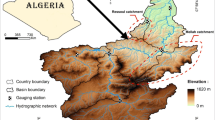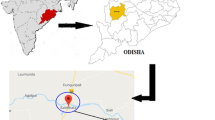Abstract
Estimation of suspended sediment loads (SSL) in rivers is an important issue in water resources management and planning. This study proposes a hybrid double feedforward neural network (HDFNN) model for daily SSL estimation, by combining fuzzy pattern-recognition and continuity equation into a structure of double neural networks. A comparison is performed between HDFNN, multi-layer feedforward neural network (MFNN), double parallel feedforward neural network (DPFNN) and hybrid feedforward neural network (HFNN) models. Based on a case study on the Muddy Creek in Montana of USA, it is found that the HDFNN model is strongly superior to the other three benchmarking models in terms of root mean squared error (RMSE) and Nash-Sutcliffe efficiency coefficient (NSEC). HDFNN model demonstrates the best generalization and estimation ability due to its configuration and capability of physically dealing with different inputs. The peak value of SSL is closely estimated by the HDFNN model as well. The performances of HDFNN model in low and medium loads are satisfactory when investigated by partitioning analysis. Thus, the HDFNN is appropriate for modeling the sediment transport process with nonlinear, fuzzy and time-varying characteristics. It explores a practical alternative for use and can be recommended as an efficient estimation model for SSL.





Similar content being viewed by others
References
Afan HA, El-Shafie A, Yaseen ZM et al. (2014) ANN based sediment prediction model utilizing different input scenarios. Water Resour Manag 1–15
Alp M, Cigizoglu HK (2007) Suspended sediment load simulation by two artificial neural network methods using hydrometeorological data. Environ Model Softw 22:2–13
Aytek A, Kisi Ö (2008) A genetic programming approach to suspended sediment modelling. J Hydrol 351:288–298
Browning LS, Bauder JW, Hershberger KE, Sessoms H (2005) Irrigation return flow sourcing of sediment and flow augmentation in receiving streams: a case study. J Soil Water Conserv 60:134–141
Chen XY, Chau KW, Busari AO (2015) A comparative study of population-based optimization algorithms for downstream river flow forecasting by a hybrid neural network model. Eng Appl Artif Intell 46:258–268
Cimen M (2008) Estimation of daily suspended sediments using support vector machines. Hydrol Sci J 53:656–666
Cobaner M, Unal B, Kisi Ö (2009) Suspended sediment concentration estimation by an adaptive neuro-fuzzy and neural network approaches using hydro-meteorological data. J Hydrol 367:52–61
Demirci M, Baltaci A (2013) Prediction of suspended sediment in river using fuzzy logic and multilinear regression approaches. Neural Comput & Applic 23:145–151
Goyal MK (2014) Modeling of sediment yield prediction using M5 model tree algorithm and wavelet regression. Water Resour Manag 28:1991–2003
He M (1993) Theory, application and related problems of double parallel feedforward neural networks. Xidian University, Xi’an
He MY (1994) Double parallel feedforward neural networks with application to simulation study of flight fault inspection. Acta Aeronautica ET Aeronautica Sinica 15:877–881
He MY, Huang R (2005) Feature selection for hyperspectral data classification using double parallel feedforward neural networks. In: Fuzzy Systems and Knowledge Discovery. Springer, pp 58–66
Huang R, He MY (2007) Feature selection using double parallel feedforward neural networks and particle swarm optimization. In: Evolutionary computation, 2007. CEC 2007. IEEE Congress on. IEEE, 2007, pp 692–696
Khan A, Yang J, Wu W (2014) Double parallel feedforward neural network based on extreme learning machine with L 1/2 regularizer. Neuro Comput 128:113–118
Kisi Ö (2004) Multi-layer perceptrons with Levenberg-Marquardt training algorithm for suspended sediment concentration prediction and estimation. Hydrol Sci J 49:1025–1040
Kisi Ö, Fedakar Hİ (2014) Modeling of suspended sediment concentration carried in natural streams using fuzzy genetic approach. In: Computational intelligence techniques in earth and environmental sciences. Springer, pp 175–196
Kisi Ö, Karahan ME, Şen Z (2006) River suspended sediment modelling using a fuzzy logic approach. Hydrol Process 20:4351–4362
Kisi Ö, Haktanir T, Ardiclioglu M, Ozturk O, Yalcin E, Uludag S (2009) Adaptive neuro-fuzzy computing technique for suspended sediment estimation. Adv Eng Softw 40:438–444
Kothyari UC, Tiwari AK, Singh R (1997) Estimation of temporal variation of sediment yield from small catchments through the kinematic method. J Hydrol 203:39–57
Kouassı KL, Kouame KI, Konan KS, Angulo MS, Deme M (2013) Two-dimensional numerical simulation of the hydro-sedimentary phenomena in Lake Taabo, Côte d'ivoire. Water Resour Manag 27:4379–4394
Lafdani EK, Nia AM, Ahmadi A (2013) Daily suspended sediment load prediction using artificial neural networks and support vector machines. J Hydrol 478:50–62
Li YT, Gu RR (2003) Modeling flow and sediment transport in a river system using an artificial neural network. Environ Manag 31:122–134. doi:10.1007/s00267-002-2862-9
Li XT, Liu HW, Yin MH (2013) Differential evolution for prediction of longitudinal dispersion coefficients in natural streams. Water Resour Manag 27:5245–5260
McBean EA, Al-Nassri S (1988) Uncertainty in suspended sediment transport curves. J Hydraul Eng 114:63–74
Partal T, Cigizoglu HK (2008) Estimation and forecasting of daily suspended sediment data using wavelet-neural networks. J Hydrol 358:317–331
Qiu L, Chen SY, Nie XT (1998) A forecast model of fuzzy recognition neural networks and its application. Adv Water Sci 9:258–264
Rajaee T, Mirbagheri SA, Zounemat-Kermani M, Nourani V (2009) Daily suspended sediment concentration simulation using ANN and neuro-fuzzy models. Sci Total Environ 407:4916–4927
Rocca P, Oliveri G, Massa A (2011) Differential evolution as applied to electromagnetics. Antennas Propag Mag, IEEE 53:38–49
Storn R, Price K (1995) Differential evolution-a simple and efficient adaptive scheme for global optimization over continuous spaces. vol 3. International Computer Science Institute, Berkeley
Tayfur G, Ozdemir S, Singh VP (2003) Fuzzy logic algorithm for runoff-induced sediment transport from bare soil surfaces. Adv Water Resour 26:1249–1256
Thirumalaiah K, Deo MC (1998) River stage forecasting using artificial neural networks. J Hydrol Eng 3:26–32
Wang J, Wu W, Li ZX, Li L (2011) Convergence of gradient method for double parallel feedforward neural network. Int J Numer Anal Model 8:484–495
Yang RF, Ding J, Liu GD (1998) Preliminary study of hydrology-based artificial neural network. J Hydraul 8:23–27
Zhao RH, Chen SY (2008) A hybrid fuzzy and neural network model for hydrological forecasting in ungauged basins. IAHS-AISH Public 39–48
Zhao HQ, Qi JQ, Wand J, Zheng J, Wu W (2010) Concentration estimation of gas mixture using a wavelet-based DPFNN. Chin J Sensors Act 23:744–747
Zhong SS, Ding G (2005) Research on double parallel feedforward process neural networks and its application. Contrl Decision 20:764–768
Acknowledgments
This research was supported by Central Research Grant of Hong Kong Polytechnic University (4-ZZAD).
Author information
Authors and Affiliations
Corresponding author
Ethics declarations
Conflict of Interest
No conflict of interest
Rights and permissions
About this article
Cite this article
Chen, X.Y., Chau, K.W. A Hybrid Double Feedforward Neural Network for Suspended Sediment Load Estimation. Water Resour Manage 30, 2179–2194 (2016). https://doi.org/10.1007/s11269-016-1281-2
Received:
Accepted:
Published:
Issue Date:
DOI: https://doi.org/10.1007/s11269-016-1281-2




